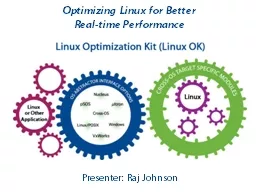PPT-RCU Usage in Linux
Author : briana-ranney | Published Date : 2017-11-19
History of concurrency in Linux Multiprocessor support 15 years ago via nonpreemption in kernel mode Todays Linux finegrain locking lockfree data structures perCPU
Presentation Embed Code
Download Presentation
Download Presentation The PPT/PDF document "RCU Usage in Linux" is the property of its rightful owner. Permission is granted to download and print the materials on this website for personal, non-commercial use only, and to display it on your personal computer provided you do not modify the materials and that you retain all copyright notices contained in the materials. By downloading content from our website, you accept the terms of this agreement.
RCU Usage in Linux: Transcript
Download Rules Of Document
"RCU Usage in Linux"The content belongs to its owner. You may download and print it for personal use, without modification, and keep all copyright notices. By downloading, you agree to these terms.
Related Documents














